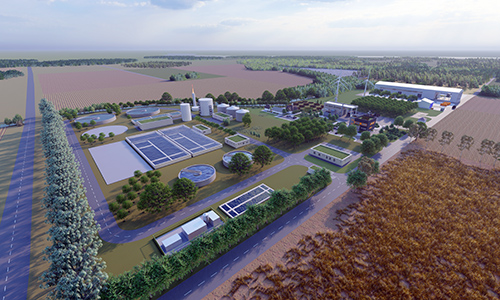Regional development agency Srem, Serbia
Reducing waste, regenerating natural resources,
and empowering local communities in an archaeological site.
Region: Srem
- CULTURE
- NATURE
- PEOPLE
Type of organisation leading the larger local innovation ecosystem
RDA Srem represents the link between the public, private and civil sectors in building strategic partnerships, realization projects with the aim of balanced regional development in Srem, Vojvodina and Serbia. One of the most significant partners in culture tourism is the Institute for the Protection of Cultural Monuments of Srem.
Main challenges related to cultural tourism
Previous practices of cultural tourism development were more based on promotion and "consumers" and less on the involvement of the local population and stakeholders. The circular economy principles have been recognised but without the application of business models.
There is a need for acquiring knowledge to accelerate the development of innovative solutions in different thematic areas: rural co-living, sensorial heritage, contemporary meanings of heritage, religious heritage, natural heritage and how to manage attractive destinations in a sustainable way, especially after the COVID-19 pandemic.
For Srem Region being part of the Be.CULTOUR Community means creating new partnerships, collaborations, exchanging good practices and developing new skills and knowledge to support policies and practics building at local and regional level, to develop innovative human-centred solutions for circular cultural tourism.
Current strategic planning
- Strategy of sustainable development of tourism in Serbia for the period 2016 - 2025.
- Vojvodina Tourism Development Program for the period 2018 - 2022.
- Strategy of sustainable tourism on Fruška Gora
- Culture Development Strategy of the Republic of Serbia from 2019 to 2029.
To guarantee the optimal use of natural and cultural resources of Srem that are the basis of tourism development through the support of environmental processes, protection of the socio-cultural heritage of the local communities.
Ideas and future perspectives
Enhancing intersectoral collaboration with a focus on the circular tourism economy regarding the Establishment of the Center for sustainable development of Srem
Mapping of culture and natural heritage of Srem and its valorisation with innovative solutions
Creating topics and culture routes that connect the region Srem with regions surrounded
Capacity building of public, civil and private sectors of Srem in bringing short and long term cultural torism strategies in local and regional level.
Cultural heritage asset description
Sirmium is an archaeological site, a city-museum of national and international importance and represents the regional cultural centre of Srem. The remains of the ancient city of Sirmium are below the current urban settlement of Sremska Mitrovica. It is near the natural, cultural and religious heritage of the National Park "Fruška gora", the Special Nature Reserve of the pond "Zasavica", the rivers Danube and Sava as a potential river port, 60 km west of Belgrade. In the southern part of Srem is the Special Nature Reserve Obedska pond is known for its diverse wetland and forest habitats, numerous species of mammals, fish, amphibians, reptiles, insects and the exceptional richness of flora, ichthyofauna and especially ornithofauna with arranged picnic areas and monuments of folk architecture.
Type of cultural heritage
- ARCHAEOLOGICAL
- RURAL
- RELIGIOUS
- NATURAL
Specific goal related to the selected asset
The goal of the development of innovative human-centred solutions for circular cultural tourism in the Srem region, its valorisation, increase its visibility and reach higher sustainability and profitability by reducing waste, regenerating natural resources, and empowering local communities. A specific goal is the capacity building of interested stakeholders of the Srem region to actively participate in the co-creation, peer-learning, improve sustainable and circular cultural tourism policies and practices.
Europeanisation: linkages between local heritage and European history and culture
The archaeological site of Sirmium represents the culture, architecture and history of the Roman Empire in the period from the first decade of the new era until the collapse of the empire at the end of the 6th century. The monasteries of Fruška Gora (Holy Mountain of Serbia) are a unique group of sacral buildings (17 in total), created from the end of the 15th to the 18th century. Eight archaeological sites located on UNESCO Tentative List Delivered – Frontiers of the Roman Empire – The Danube Limes (Serbia).
European and international Cultural Heritage recognition(s)
Originated from the Pannonian Sea, Fruška gora is a unique natural phenomenon with over 1500 species of plants, 211 species of birds and 60 species of mammals (Important Bird Area, IBA - 011SER), is the oldest national park in Serbia. SNR “Obedska bara” and SNR "Zasavica" are significant nature habitats in Srem with identified areas of protection within the different international ecological networks. The Roman Emperors' Way and the Danube Wine Route is the Council of Europe's first cultural route from Southeast EU.
Ongoing projects and best practices
- Establishment of the Center for sustainable development of Srem, (link)
- RecRoad 2016-2017, Viability in the country of Srem. Horizon 2020 Program
- ARCHEST project: Education of archeological visitors along the Roman road Aquileia-EmonaSirmium-Viminacium.
- Roads of the Roman emperors and the Danube wine route in cooperation with the Danube Competence Center and GIZ GmbH
- Bicycle tourism toward rural and regional development Srem
- Cycling Danube – the establishment of the regional cycling route Srem


